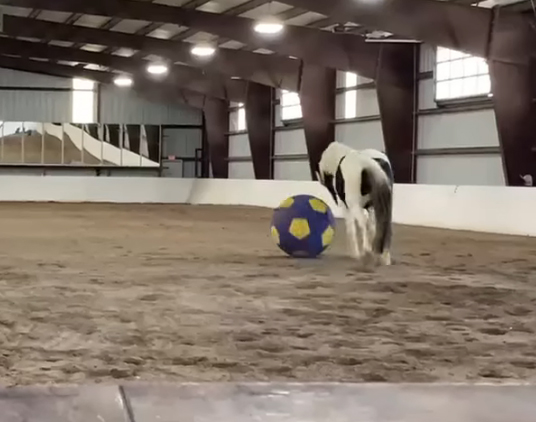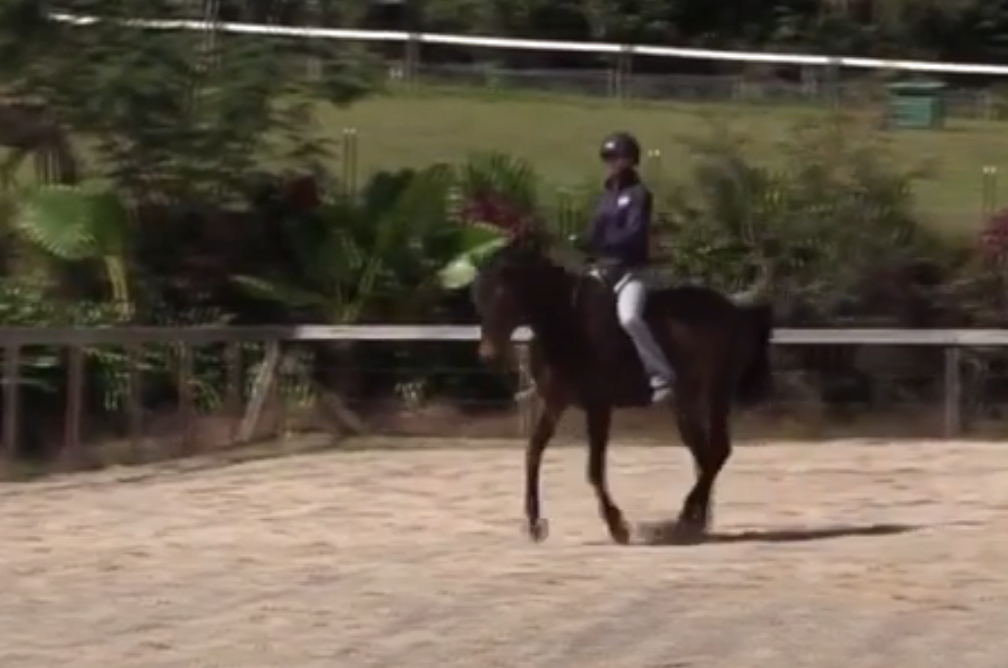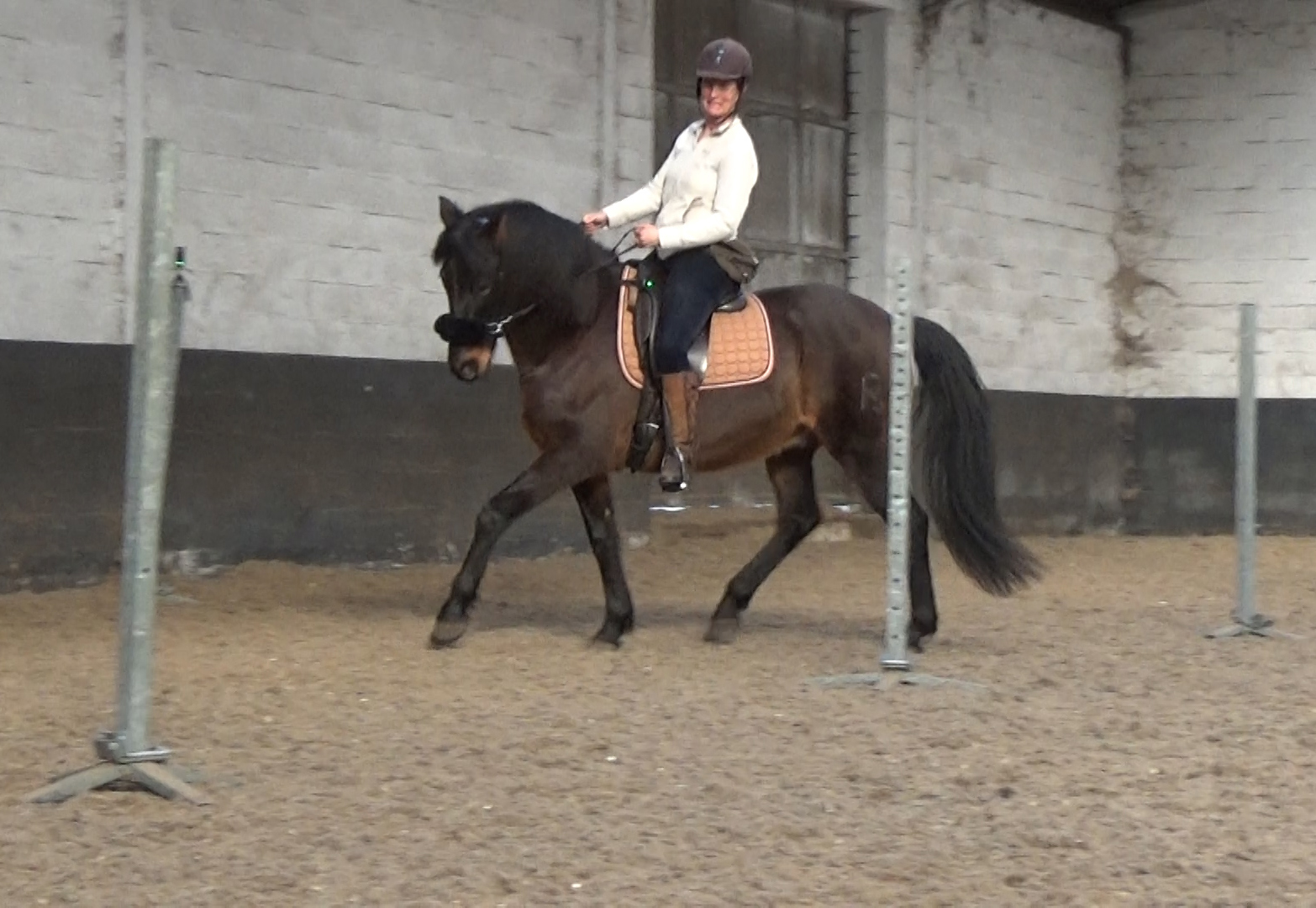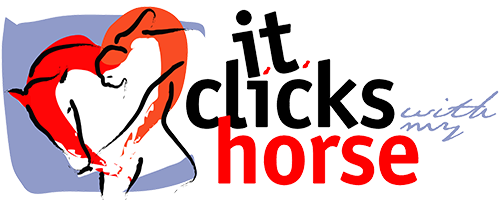RESHAPING DRESSAGE
An open letter to the “real horse world” out there
Show me a passage
Up until now, clicker training hasn’t really been taken serious in the “real” world (read: the competition world). There’s somewhat more curiosity in the academic dressage world. The problem is: as long as no one can show a piaffe or passage which has been trained completely with positive reinforcement, no one believes it. Clicker training is seen at the most as good for ‘playing around’, solving acute hoof giving problems, or ’trick training’.
It’s no wonder that clicker training is being confused with positive reinforcement – even most clicker trainers do. That is because, at the dawn of clicker training, it indeed was all about the discovery of positive reinforcement for training horses.
This turning towards positive reinforcement to explain stuff already is a huge revolution in and of itself, especially in the horse world where coercion sits at the core of every single riding aid (it’s all about negative reinforcement and way too much positive punishment).
Learning to work with positive reinforcement teaches you to stay away from those automatically applied, plentiful but unnecessary aversives. That doesn’t come easy to most people. Everyone loves his/her horse, but it’s a lot harder to admit that the only way you got your horse to do this or that up until now, was the “or else”. After all, that’s how we’ve all been doing it for thousands of years.
Yet we keep on disappointing that “real world” because we don’t seem to be able to produce that perfect piaffe without some form of aversiveness. It’s a painful thing – quite literally for our horses, mentally for clicker trainers at the forefront of its development, but also for those dressage people who are skeptic, but still feel enough cognitive dissonance about it… which betrays their secret wish that it could be true, that pink unicorn promise of non-violence.
Clicker training as it stands is far from a perfect training method. All clicker trainers are pioneers. We stumble and fall. We try something, then abandon it again, because the initial promise doesn’t materialize. It’s motivation science, being developed in the real world by non-scientists. And as one of those self-appointed non-scientist developers, I’m starting to think we keep asking the wrong questions.
But first, a recap on what clicker training is.
it’s not about the food
The first thing to remember is: it’s called clicker training, not food training. It’s the bridge (the click, the “yes”, the “good”, the “ex”) that’s the core magic. Not right away, but through time that click will develop into one of the strongest communication tools that exist in interspecies communication: saying out loud that “you did [this particular thing] well, and here’s your reward”.
The power of clicker training sits in the click. Your horse will start to rely on it. It’ll be his compass through learning anything new. Clicker training is an amazingly strong and finetuned feedback system.
Clicker trainers don’t use carrots simply because we think carrots are best. It’s because we think we should reward with what the HORSE finds rewarding. It just so happens to be that carrots are, ahum, top dog when it comes to most horses’ reward preferences list. Horses do a LOT to get carrots.
So yes, we do work with a lot of positive reinforcement (without first applying something aversive, or increasing the aversiveness if the animal doesn’t do it). Initially almost exclusively.
Only much later on we will start using positive reinforcement in combination with some mild “aversives”, in very specific and thought-through setups. It’d take an entirely separate article of book length to explain “mild” within tactile cues, including a lecture on second degree classical conditioning (the way emotions get triggered by learned cues, so that the past determines how future challenges will feel) and superimposition (how different reward schedules work together or against each other in some sort of motivational cocktail). In short: the click becomes a secondary reinforcer; the horse starts liking the click because the click is always tied to the food, which is the primary reinforcer. From there, even the cue becomes a tertiary reinforcer: the onset of the cue/prompt/ “aid” starts to be liked because the cue always leads to the click which always leads to the carrot. Much like how a traffic light jumping to green is liked by a human because it’ll get him where he wants to be.
Yes, horses do a lot to get carrots. But that’s not the sole reason why clicker training works so well. If that were the case, we’d be manipulating horses into doing something they don’t want to do. Sure, some clicker trainers probably are evil manipulators. Most of us don’t have the insight to be able to pull that off though (I know I don’t – my horse still does a lot of things without me having any control over it whatsoever).
But remember that “developing interspecies communication” thing? That’s what’s really going on here. Carrots, as it turns out, is merely scratching the surface. We’re only just now starting to see the bigger picture.
You see, a kilo of carrots doesn’t explain why the biggest problem of clicker trainers is that horses don’t want to stop the training session. With other training methods, the biggest reward a horse can get is that we get off his back (literally and/or figuratively) and bring him back to his pasture (not box please. It’s old fashioned, bad ethics and against science to lock up your horse in a cage). In short: his biggest reward is that you are away.
Clicker trainers on the other hand have to go through teaching an ‘end-of-session ritual’, because suddenly nothing is as punishing as the trainer going away. Horses who need to be comforted when you end the training? Dang! Clearly, something much larger than “getting carrots” is happening there.
autonomy
So where do we see this happening as well, this reluctance to step outside of the experience?
Games, and more specifically: online games like first person shooters (fps) and massive multiplayer online roleplay games (mmorpgs or mmo’s for short). Delving into game mechanics makes it more clear why clicker training works, and how it can work even better.
There are a few very clear reasons why games get people to step into a mostly aversive virtual world to get increasingly more difficult things done and have fun while doing it – something that regular education seems to fail at for an awful lot of people. And clicker training seems to have stumbled upon some of that.
First of all: a game is fun because it’s voluntarily. As soon as it starts to be something that you HAVE to do, it stops being fun. Ask anyone who made a job out of his hobby: when it has to bring in supermarket money, it loses a lot of its shine.
In ‘normal’ dressage, horses don’t do it voluntarily. They do it because else there’s the rope, the whip, the spurs, the pull of the rein. Sure, they can learn enjoying it even through aversives. It’s very rewarding to know how to stay ahead of the aversives, and what the rules are on avoiding them. But still: it’s the memory of the aversiveness that motivates the behavior.
In clicker training, the horse is free to not cooperate. Yes, he doesn’t get that carrot slice, but otherwise he’s free to leave any time and go eat the grass at the border of the arena. The human is not even allowed to pull at a lead rope to get him back to ‘work’, nope – all he can do is become a better entertainer, by making it easier or increase the reward or come up with something else entirely. It’s up to the horse if he wants to play the game.
The horse has all the power. That’s what makes it so mind blowing for humans AND for horses: the horses finally get a say in things, and the humans finally get to meet the willing adult inside the horse.
It’s a fragile and tricky thing though, that fun. You can teach a horse to find the fun in, let’s say, chasing a ball (where before he’d be afraid of its erratic movements). But if you go on rewarding every time he has fun, you put that fun under your control, the game becomes work, and the fun disappears again. We’ve all seen that happen. That’s why clicker trainers are experimenting so much with choice setups.
Because carrots have a limited appeal. Autonomous fun doesn’t.

This is Jet, from Shawna Karrash. Jet is playing with a ball, because he thinks that’s fun.
Okay, he may be a bit on his forehand, but he is also joyfully learning to bend on a circle, and the size of the ball helps him to stay upright.
challenge
There’s more. You’d think we make it all too easy for our horses. But if the human makes it too easy for too long, the horse walks away as well. If you’ve done the same thing a few times too much, anyone would get bored. So do horses.And that brings us back to another reason why a game is fun.
Games have rules. Rules make it harder to get to the goal. It’s the entire point of games: how to beat the system that is the game, within its constraints. Rules in games are consequences of the environment, like the limited use of objects, limited time, or adversaries that make it even harder to get to the goal. Lo and behold: rules ARE aversives, but they are accepted willingly.
You see, it’s exactly the aversiveness that makes things interesting. The aversions ARE the challenge. Not enough aversiveness and a player goes into bottom feeding (do as least as possible out of boredom). Too much aversiveness, and the player is rage quitting (drop the game because of frustration).
Game designers are masters at keeping people entertained by making things harder and harder, but not too hard too fast. To that end there’s always just enough challenge and unpredictability. There’s a lesson in there for us riders: it’s not that we can’t “use” aversiveness anymore. It’s just that aversiveness should be presented in a different, more honest way. With clicker training, just as in games, aversiveness is in the challenge, not in the coercion. Aversiveness is fun, IF the player feels like he has a choice about tackling it, gets the means to tackle it, and is rewarded for beating it.

This is Georgia Bruce, twice para Olympic dressage for Australia, and Rumba, both caught on video.
Rumba is in the midst of a flying change. It’s not perfect, but then again: there’s no tack to hold it all together, except for the neck ring.
Rumba knows exactly when he did it right, because he’ll hear the click. It’s a traditional dressage exercize, shaped step by step in an untraditional way: with clicker training.
goals
Last but not least, as mentioned before: games have goals. For humans, horse games have obvious goals: jump those obstacles in the right order, within a certain time, and without knocking the poles off.
Those goals are not so obvious for horses, especially when it comes to dressage. A dressage test is far from making sense to a horse: you have to do such and such with body (and soul!), while going nowhere at a tempo that every sane horse thinks is pointless and even dangerous (horses in a pasture save energy and only run when it’s needed).
Comes in clicker training with its seemingly weird and useless fad objects: targets. Mats, balls, noodles, cones, target sticks, symbols even.
Targets are much more than objects that lead to carrots. Targets are objective, understandable, tangible goals. From seeing the target, the horse knows exactly what the job is, how to get there, what to do with it and that when he gets there, a reward will follow.
I truly believe this is why horses who jump courses or do cow cutting know their jobs better and can do them pretty decently without a human on their back: showjumping obstacles and cows are targets.
Dressage doesn’t have those targets. That’s why dressage needs so much micromanagement. The first horse who voluntarily goes on piaffing and then flawlessly transitions into a collected passage after he lost his rider somewhere earlier still has to pop up on my facebook feed.

Brigitte and Generoso, both learning what it means to stay upright while bending, through a game: weaving through poles.
This is the moment where Generoso fails: he’ll miss the next pole because he doesn’t bend enough. He won’t be getting to the end goal now: the mat. He’ll have to restart. But he’ll learn from this round: to succeed, he’ll need to focus.
This is also the moment where Brigitte, his rider, pings on how the outside rein and inside hind leg work together to help Generoso bend.
The next round, they’ll make it.
Brigitte and Generoso aren’t doing dressage. They are playing a game. Their rewards: making it through the challenges, arriving at the mat, one carrot slice, and a lot of fun.
And that last one, that brings me back to where I started: when we ask ourselves whether we can teach a passage with positive reinforcement alone, isn’t that the wrong question entirely?
Should it really be the ultimate goal to have the horse move in this artificial manner if he doesn’t offer it voluntarily because it doesn’t make sense to him?
Yes yes, I know we are supposed to get the horse collected because he’ll stay healthier physically while carrying our weight. But are horses who can perform passage really healthier than horses who don’t? Do they live longer and happier because they learned to piaffe, compared to, say, horses that can merely produce a somewhat decent shoulder-in, can barely stay upright while bending between poles but are champions at fetching cones?
My gut feeling tells me that there’s a Bell curve somewhere in there: after a while, dressage becomes better for humans, but less so for horses. After that long history of dealing with all those small aversives inside the “aids”, the biggest aversive in a horse’s life may be his human’s ambition.
So up to a certain point, I completely agree with the objectives of dressage: a horse really should learn how to carry his rider without hurting himself… if he chooses to carry that rider. If he knows a rider on his back will help him get to a goal that he wants to attain and to that end wants a rider on his back.
Beyond that, passage as we know it is merely a coerced trick, and to be honest, compared to chasing that ball: probably way less fun for the horse. Honestly, I’m way more impressed by someone who can get his horse to run to a mounting block voluntarily so that with a rider on his back, that rider will help him find his way through a silly obstacle course in order to end upon the mat, than by the ‘high level’ passages I see on my screen.
Does that mean you shouldn’t teach your horse passage? Nope. I’ve seen that horses who are allowed to choose, choose the difficult stuff over the easy stuff. Because that’s more fun.
Maybe your horse will want to passage with you on his back – much like he’ll choose to passage when showing off to that pretty mare in the other pasture. Can we get there in a different manner than we do now? With silly games like playing with balls, standing on pedestals, bending through poles on his route to a mat, where our horse trains attitude and muscles in a playful way, enjoying himself thoroughly? Maybe then he will get a kick of hearing that click right when all those tricky criteria for passage come together.
If you think that’d be neat, allow yourself to acknowledge that loving your horse means that the way to get there is much, much more important than that silly end behavior in itself. With time and patience and a LOT of fun on his goodwill savings account. Without coercion, and through decent game design.
Let’s shape our horses to WANT to do difficult things… because it’s fun.
Let’s reinvent dressage.
Inge Teblick, 26/01/2021
